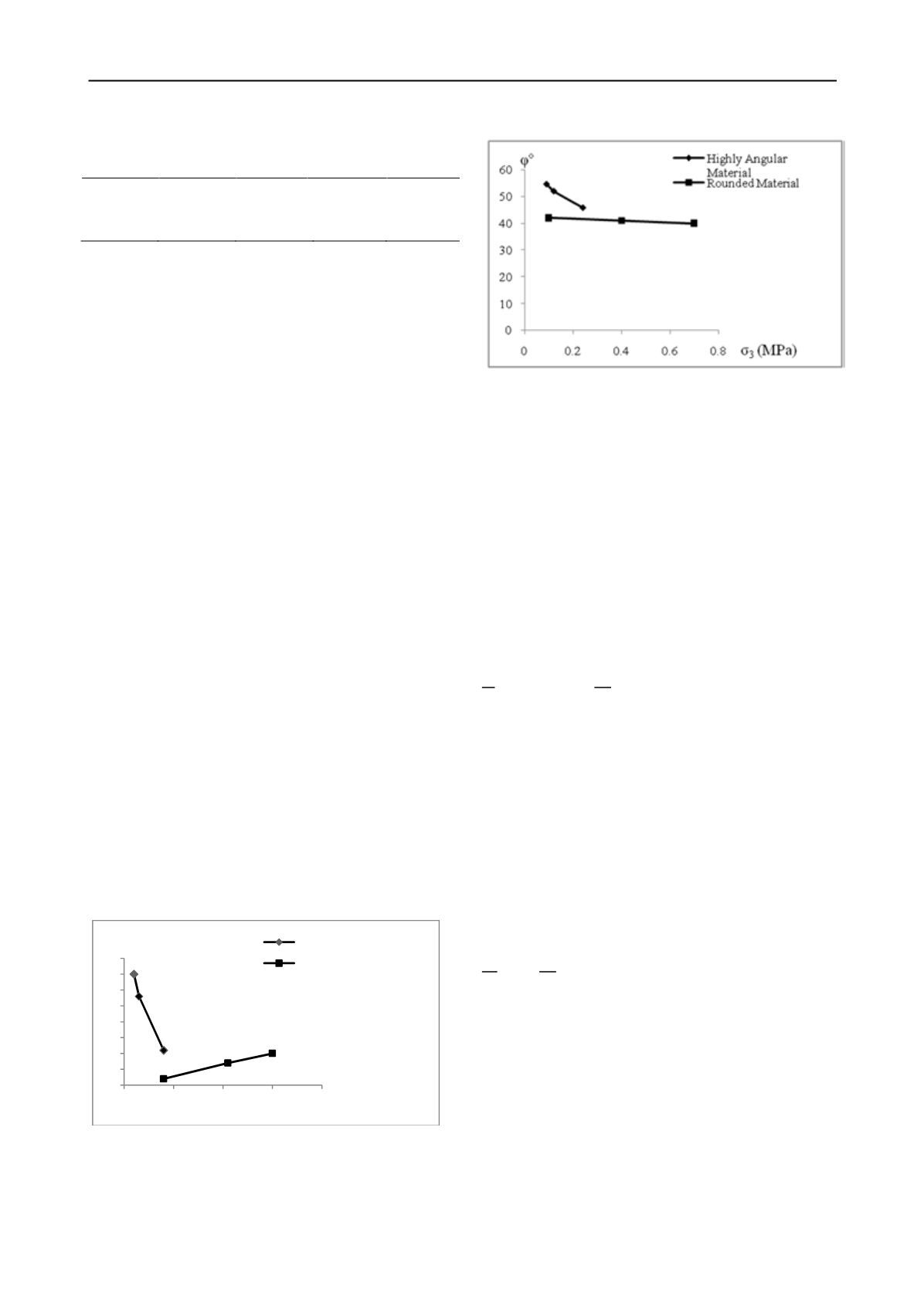
355
Technical Committee 101 - Session II /
Comité technique 101 - Session II
Table 3. Average values of n and K for relatively rounded and relatively
angular rockfill materials, compared with typical values for loose and
dense sands
Type of
Materials
Relatively
Angular
Relatively
Rounded
Loose
Sand
Dense
Sand
n
0.085
0.29
0.65
0.54
K
2004
700
300
2000
The main factor responsible for the comparatively lower
(compared with sands) average values of n for the rockfill
materials (especially the angular ones) is particles breakage
which happens during both compression and shearing of the
materials.
A
c
cording to Eq. 4, n represents the exponential effect of
σ
3
on E
i
. As particle breakage in rockfill materials is far more than
in sands, the average n value of rockfill materials is much less
than that of sands. Materials with higher degrees of angularity
suffer more particle breakage and therefore, they have lower
values of n.
The modulus number (K in Eq. 4) for the studied rockfill
materials takes values ranging widely from 53 to 36×10
9
. The
very high values of K correspond to negative values of n.
4 VARIATION OF E
i
AND
φ
WITH CONFINING
PRESSURES (
σ
3
)
Figure 3 shows the variations of E
i
with
σ
3
while shown in
Figure 4 is the variations of
φ
with
σ
3
for one of the highly
angular and one of the rounded materials which are studied in
this paper. As Figure 3 shows, because of massive particle
breakage, the increasing of
σ
3
has resulted in the reduction of E
i
for the highly angular rockfill material, while E
i
has increased
with a gentle slope with the increase of
σ
3
for the rounded
rockfill material. Moreover, the rate of reduction of
φ
with the
increase of confining pressure is much more for the highly
angular material than for the rounded material, as presented in
Figure 4.
The above trends of variations were obvious more or less in
the behavior of the rest of the materials. Our studies on the
behavior of the materials showed that the following factors have
major effects on the rate of particle breakage:
- Shape of particles: angular particles undergo more
breakage.
- Mineralogy: particles of weaker materials break more.
- Size of particles: coarse particles are more vulnerable to
breakage.
- Coefficient of Uniformity (C
u
): A lower C
u
, causes a higher
rate of particle breakage.
Figure 3. Variations of E
i
with
σ
3
for typical rounded and highly angular
rockfill materials
Figure 4. Variations of
φ
with
σ
3
for typical rounded and highly angular
rockfill materials
It should be mentioned that according to Equation 4, the
particle breakage phenomenon affects the tangential
deformation modulus (E
t
) of rockfill materials by both "n" and
"φ "
.
The above conclusions strongly suggest that the variations of
deformation modulus of rockfill materials with confining
pressure should be taken into account in deformation analyses
of rockfill structures.
5 CORRELATION BETWEEN E
i
AND
φ
WITH
σ
3
This study on the triaxial testing results of the rockfill materials
led to two correlations between E
i
and
φ
with
σ
3
. They are as
follows:
∆
0
α log
1
∆
3
3 0
(5)
where
∆φ
= reduction of internal friction angle;
φ
0
= internal
friction angle corresponding to
σ
30
;
σ
30
= initial confining stress,
which is usually the minimum confining stress in triaxial
testing;
∆σ
3
= confining pressure increase; and
α
= a coefficient
depending on shape of particles, coefficient of uniformity (C
u
),
and confining pressure increment ratio (
∆σ
3
/
σ
30
).
Considering the studied rockfill materials,
α
ranges between
0.051 and 0.59 for the relatively angular materials and between
0.046 and 0.42 for the relatively rounded materials.
It implies that
α
for the rounded materials are generally less
than that for the angular ones; this represents the lower particle
breakage potential for the rounded materials.
The relationship for variation of E
i
with
σ
3
is suggested, as
follows:
∆
0
β
∆
3
3 0
(6)
where
∆
E
i
= changes in initial elasticity modulus; E
i0
=initial
elasticity modulus corresponding to
σ
30
; and
β
= a coefficient
depending on particle shapes, uniformity coefficient (C
u
), and
∆σ
3
/
σ
30
in triaxial compression shearing.
For the relatively angular materials,
β
was calculated as
-2.65
≤
β ≤
3.71 and for the relatively rounded materials as
-1.14
≤
β ≤
5.50. It is observed that the range of positive values
of
β
, which implies the increase of E
i
with
σ
3
, for the relatively
angular materials are smaller than the similar range for the
rounded materials (3.71 versus 5.50). For the range of negative
values of
β
, which implies the decrease of E
i
with
σ
3
, the trend
is opposite (-2.65 versus -1.14). The above observation is
logical concerning comparatively higher particle breakage and
its reductive effect on E
i
in the relatively angular materials.
0
50
100
150
200
250
300
350
400
0
0,5
1
1,5
2
Highly Angular Material
Rounded Material
E
i
(MPa)
σ
3
(MPa)


